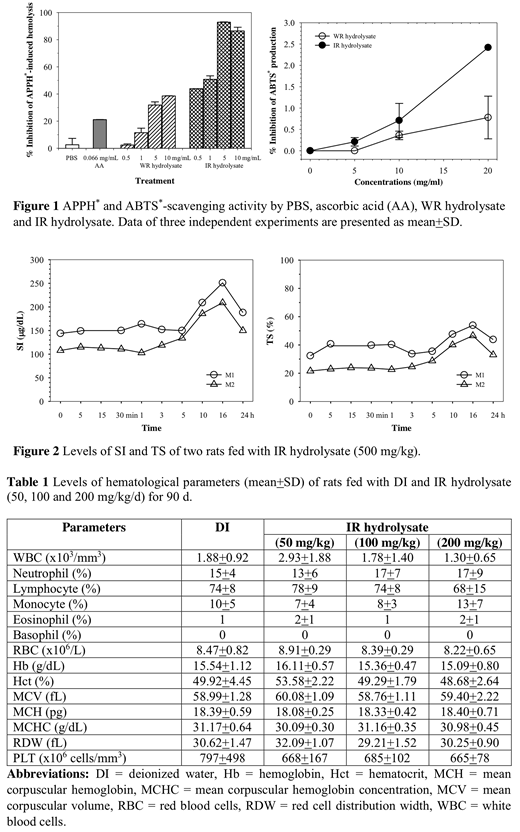Iron-deficiency anemia (IDA) is the major cause of anemia in developing countries commonly associated with poor nutrition, pregnancy, celiac disease, hook-worm infestation and aging process. Iron fortification in staple food is recommended to help preventing IDA; however, the iron dosing may cause adverse effects and oxidative damage to the gut lumen resulting in gastrointestinal irritation and poor absorption. The Thai Sinlek rice (Oryza sativaL.) (IR) was developed as a new crossbreed of Jasmine (Hom nin) rice and white (Hom Mali 105) rice (WR) and is abundant with iron, phenolic compounds, tocopherols and tocotrienols. Previously, the consumption of IR drink (14.7 mg/100-mL serving/d) for 1 month significantly increased levels of hemoglobin (Hb) and tended to increase levels of serum iron (SI) and transferrin saturation (TS) in anemic elderly subjects. However, the nutraceutical effect of IR from iron fortification together with potential oxidative effects have not been properly tested in an animal model.
To prepare the functional IR, we digested IR grains with a-amylase and dried the hydrolysate by using lyophilization technique. Iron content of the hydrolysate was determined using ferrozine colorimetric and inductively coupled plasma-mass spectrometry (ICP-MS) methods. IR hydrolysate was found to contain 13.9 mg iron/g dry weight compared with 1.94 mg iron/g in white rice (WR). Antioxidant activity was assayed using 2,2'-azino-bis (3-ethylbenzthiazoline-6-sulphonic acid radical (ABTS*) decolorizing method,and anti-hemolysis activity was determined using 2,2-azobis(2-amidinopropane) dihydrochloride radical (AAPH*) induced red blood cells (RBC) method as shown in Figure 1. The IR hydrolysate has higher antioxidant and anti-hemolysis activities in a dose dependent manner compared to the WR hydrolysate and controls (PBS). HPLC analysis also showed some amounts of phenolic compounds, g-oryzanol, tocopherols and tocotrienols in the IR hydrolysate (data not shown).
To assess luminal absorptivity of iron, two Wistar rats were fed once with the IR hydrolysate (500 mg/kg body weight) and collected blood samples at different time points for 24 h. The finding reveals an increment of serum iron (SI) and transferrin saturation (TS) levels at 5 h and the maximum levels at 15 h (Figure 2).
Finally, to study nutraceutical effects of the IR hydrolysate, Wistar rats (5 males, 5 females) were fed with the IR (50, 100 and 200 mg/kg) for 3 months and sacrificed for blood collection and analysis. Hematological parameters were determined using an automated Coulter cell counter (Table 1). The treatment with the IR at 50 mg/kg was found to increase significantly levels of RBC parameters e.g., Hb, hematocrit (Hct), red blood cell counts (RBC) and mean corpuscular volume (MCV) and total white blood count compared to higher dosing of the IR and control with deionized water (DI). In the highest IR dose (200 mg/kg), Hb, Hct and RBC were lowest suggesting a potential iron related toxicity probably on chronic intestinal inflammation. Our finding highlights that the optimal use of the IR should balance between the benefit from iron fortification to enhance hematopoiesis by preventing IDA against the risk of iron toxicity from dosing due to excessive free iron species and redox activity generation.
No relevant conflicts of interest to declare.
Author notes
Asterisk with author names denotes non-ASH members.


